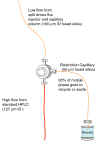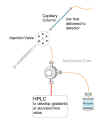Return to IonSource Homepage
Plumbing and Dead Volume Reduction Tips |
Click on the thumb nails in this column for a larger view |
|
It is always wise to follow good HPLC plumbing practices. At higher flow rates 5-8 µL/min the capillary conversion is robust and can take a lot of abuse, but if you want your new capillary HPLC to run at top performance take extra care to reduce unnecessary dead volume and leaks. While the capillary system will run with finger tight connections, we prefer to use the appropriate metal nuts and ferrules for all connections. Metal connections last longer and it is easier to be sure that the manufacturer specifications are met for ferrule and receptacle. For example the tee and capillary column normally come with the appropriate nut and ferrule making the likelihood of connection dead volume due to incompatibility less likely. Valco, Waters and Vydac replacement nuts and ferrules are readily available. Also, take care that the tubing is bottomed out or flush when swaging and making connections. HPLC Tubing We construct the restriction capillary from 50 micron ID fused silica tubing. (see Figure 1). The tubing coming from the HPLC pumps can be made from any appropriate HPLC tubing (stainless steel, PEEK™, fsc etc...). For all connections to the capillary column we use 50 micron ID fused silica tubing (fsc). The volume of 50 centimeters of a 50 µM ID fsc tube is approximately 1 µL, so apparently long lengths of tubing contribute relatively low dead volumes. The fused silica with it's polyimide coating is very pliable and easily cut to size with a ceramic knife. Fused silica, due to it's small size and pliability is also ideal for plumbing within an existing HPLC. Swaging Ferrules to Fused Silica.
|
 Figure 1 |
 Figure 2 |
|
 Figure 3 |
|
|
. |
|
|
TOC Introduction Glossary Simple System Automation UV Detection Plumbing The Truth About Splitting Applications Order Components References |
 |
| - | |
|
home
| disclaimer |
|